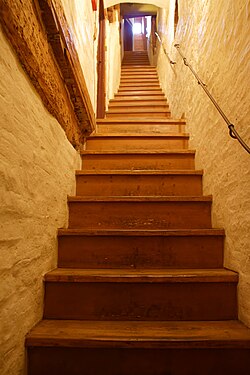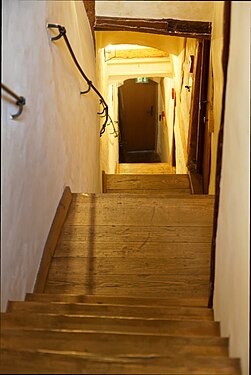Ladder to Heaven (architecture)
As Jacob's ladder in is architecture a particular design of a staircase or a staircase designated as especially in medieval buildings, particularly in Munich was used.
description
A ladder to heaven is a straight staircase that connects several floors. Usually it is bounded directly on both sides by the wall of the staircase, so that the staircase does not have a larger area than the staircase itself. There is usually a landing at the entrances to the individual floors . From the foot of the stairs you can see all the way to the top floor. A window at the end of the stairwell usually lets in light. This creates the impression that the staircase extends all the way to heaven - as with the heavenly staircases laid out in the open air .
This type of construction became common in Munich from the late Middle Ages. In the Ignaz-Günther-Haus, for example, there is a three-story ladder to heaven from the 15th century, and in Haus Sterneckerstraße 2 there is a four-story ladder to heaven from the 16th century. This construction method was favored by the shape of the plots in Munich's old town , which were often deep and narrow.
Examples received
Historical ladders to heaven have been preserved, for example, in the following buildings:
- Weinstadl , Burgstrasse 5, Munich, former town clerk's house
- Burgstrasse 8 , Munich
- Oberanger 11, Munich, part of the Ignaz Günther House
- Beer and Oktoberfest Museum , Sterneckerstraße 2 , Munich
Based on the historical model, stairs were created in the following buildings, for example:
- Alte Pinakothek , Munich (during reconstruction after WWII )
- Bavarian State Chancellery , Munich
- Jewish Museum Munich , Munich
- New building for the Max Planck Society at the Hofgarten in Munich
- Construction of the Bauhaus Museum in Weimar
Recent examples:
- Staircase in the Globetrotter branch in Cologne
- Entrance to the Paul-Löbe-Haus
Literary processing
Thomas Mann mentions a ladder to heaven in his novel Buddenbrooks , where the protagonist Alois Permaneder lets his wife Tony catch him talking to the cook Babette. Since Elisabeth Mann , the model of Tony Buddenbrook, lived in Esslingen, a "heavenly ladder" is claimed in Elisabeth's house in Webergasse, which, unlike the heavenly ladder known to Thomas Mann from his time in Munich, only has two floors connects with each other.
Web links
- Jörg Niendorf: Placemark (9): Stairs without a kink. In: faz.net . September 25, 2010 .
Individual evidence
- ↑ a b c d Jörg Niendorf: Placemark (9): Staircase without a kink. In: faz.net . September 25, 2010, accessed November 4, 2021 .
- ^ Heinrich Habel, Johannes Hallinger, Timm Weski: Burgstrasse 5 . In: City of Munich - center . Karl M. Lipp Verlag, Munich 2009, p. 149 .
- ^ Heinrich Habel, Johannes Hallinger, Timm Weski: Burgstrasse 8 . In: City of Munich - center . Karl M. Lipp Verlag, Munich 2009, p. 150 ff .
- ^ Heinrich Habel, Johannes Hallinger, Timm Weski: St.-Jakobs-Platz 20 (with Oberanger 11) . In: City of Munich - center . Karl M. Lipp Verlag, Munich 2009, p. 989 f .
- ^ Heinrich Habel, Johannes Hallinger, Timm Weski: Sterneckerstraße 2 . In: City of Munich - center . Karl M. Lipp Verlag, Munich 2009, p. 1075 ff .
- ↑ Wolfgang Diehl: Himmelsleiter motif. In: treppenforschung.de. Society for Staircase Research Scalalogie eV, 2016, accessed on November 4, 2021 .
- ↑ Albert von Schirnding: ... "the 'unlitterary' city par excellence" ... Thomas Mann and the Munich of the Pringsheim family . In: Thomas Mann Yearbook . tape 15 . Vittorio Klostermann, 2002, p. 201-208 , JSTOR : 24744277 .



